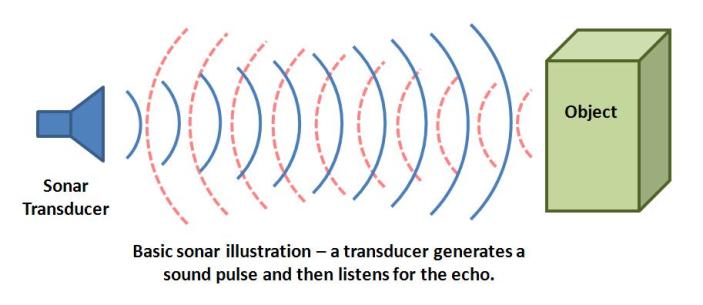Ultrasonic Distance Sensor
Understanding the Science Behind the Ultrasonic Distance Sensor
How does an Ultrasonic Distance Sensor work?
The Ultrasonic Sensor sends out a high-frequency sound pulse and then times how long it takes for the echo of the sound to reflect back. The sensor has 2 openings on its front. One opening transmits ultrasonic waves, (like a tiny speaker), the other receives them, (like a tiny microphone).
The speed of sound is approximately 341 meters (1100 feet) per second in air. The ultrasonic sensor uses this information along with the time difference between sending and receiving the sound pulse to determine the distance to an object. It uses the following mathematical equation:
Distance = Time x Speed of Sound divided by 2
Time = the time between when an ultrasonic wave is transmitted and when it is received
You divide this number by 2 because the sound wave has to travel to the object and back.
How it works: A chirp is emitted from the “speaker.” It bounces off of an object. The echo returns to the microphone. The time it takes to travel to the object and back is used to figure out the distance.
For a Visual Example CLICK HERE (Click BACK to get Back)
Uses of the Ultrasonic Sensor
Lots more technical information:
http://www.sensorwiki.org/doku.php/sensors/ultrasound
Applications of ultrasonic sensors: Driverless cars etc.
What Does Sound Look Like?
Why/When to use Ultrasonic Sensors ?
- Ideally suited to accurate, automatic distance measurement in normal and difficult environments
- Particularly suitable for environments where optical sensors are unusable such as smoke, dust and similar.
- Very accurate, stable and can be used over large ranges.
Ultrasonic sensors can measure the following parameters without contacting the medium to be measured:
- Distance
- Level
- Diameter
- Presence
- Position
Ultrasonic sensors make accurate measurements in many difficult environments and unusual materials. Measurements are unaffected by:
- Material
- Surface
- Light
- Dust
- Mist and Vapor
Ultrasound in Nature: How animals use it
The Tarsier’s ears are able to pick up sounds at a distinctly squeaky 90kHz. Read more: http://www.dailymail.co.uk/sciencetech/article-2098329/Philippine-Tarsier-monkey-talks-ultrasound.html#ixzz2vrnjXYBf Follow us: @MailOnline on Twitter | DailyMail on Facebook |}==
Animals that Communicate & Navigate using Ultrasound
The Ultrasonic Distance Sensor uses a similar technique to the echolocation sonar used by different animals. Is this where scientists discovered the idea?
It turns out that the history of the Ultrasonic sensor dates back to at least 1790, when Lazzaro Spallanzani first discovered that bats maneuvered in flight using their hearing rather than sight.
Spallanzani conducted extensive experiments on the navigation in complete darkness by bats, where he concluded that bats use sound and their ears for navigation in total darkness (see animal echolocation). He was the pioneer of the original study of echolocation, though his study was limited to what he could observe. Later scientists moved onto studies of the sensory mechanisms and processing of this information. (http://en.wikipedia.org/wiki/Lazzaro_Spallanzani)
| David Griffin |
In the 1930's, Scientist Donald Griffin was the first to confirm that bats navigate using sound.Working with George Washington Pierce and Robert Galambos at Harvard, Griffin solved the long-standing mystery of bats’ remarkable ability to navigate in the dark. The bats emitted ultrasonic cries and heard the reflected sound waves to pinpoint objects in their flight path. Griffin called the bats’ sensory-acoustic form of navigation echolocation. Read more: http://www.apa.org/monitor/2011/04/batman.aspx
Below is a timeline of how ultrasonic technology developed.
Read more: http://www.engineersgarage.com/articles/ultrasonic-sensors
| http://www.engineersgarage.com/articles/ultrasonic-sensors |
The ability to detect and emit ultrasonic frequencies, which are above the human hearing range, is an essential survival tool for many animals. Certain nocturnal and marine animals rely on sensitive ultrasonic systems for navigation and finding prey, while some insects use ultrasonic hearing to detect and escape predators. This ability is known as Echolocation, and it is important to many animals.
What is Echolocation? "Echolocation is the use of sound waves and echoes to determine where objects are in space" http://askabiologist.asu.edu/echolocation Any sound above 20 kilohertz (20,000 hertz) is considered Ultrasound, and these sounds are above the range of human hearing. Many animals have the ability to not only hear ultrasound, but to produce it as well. Here are a few of the amazing animals and insects who use Ultrasonic communication and navigation:
Mouse House mice use Ultrasonic sounds to attract the opposite sex. Rats and other rodents also use it for communication.
Bat
Bats, Dolphins and Toothed Whales Navigate and hunt using Ultrasonic Echolocation
Dolphin
http://animals.howstuffworks.com/mammals/dolphin-disarm-sea-mine1.htm
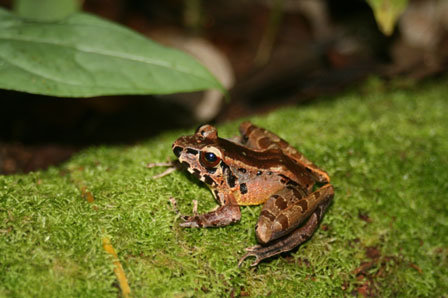
Huia Cavitympanum
The only known frog species that can communicate using purely ultrasonic calls, whose frequencies are too high to be heard by humans. is known as Huia cavitympanum. This unusual frog lives only on the Southeast Asian island of Borneo.
Ultrasound is much higher than the 5 to 8 kHz frequencies most amphibians, reptiles and birds are capable of hearing or producing. Key parts of the ear must be specially adapted to detect ultrasounds.
These frogs can hear sounds up to 38 kilohertz, the highest frequency any amphibian species has been known to hear. Humans can hear up to about 20 kHz and typically talk at 2 or 3 kHz.
Huia cavitympanum produces some audible calls and others that are entirely ultrasonic.
"You look at the frog and can see it is vocalizing — you can tell because their vocal pouches pulsate — but you don't hear any sound. It's amazing," scientist Arch said. "Then you look down at the recording equipment and see the lights flashing, indicating sound. I have never seen that before. In a frog, it's unprecedented to have purely ultrasonic vocalizations."
http://www.usnews.com/science/articles/2009/05/12/study-frogs-use-ultrasound-to-communicate
Insects such as Moths, Katydids and Lacewings use Ultrasonic Echolocation to escape predators
| Tiger Moth |
Tiger Moth
The Tiger Moth Can emit ultrasonic clicks to "jam" a Bat's sonar
The tiger moth produces ultrasound not to communicate, but as a defense mechanism. By producing ultrasound of its own, it is able to ward off bats by acting as a radar jammer, confusing the bats so that the moths cannot be located. By doing this, they add another weapon to their survival mechanisms that also includes poison. Wikipedia
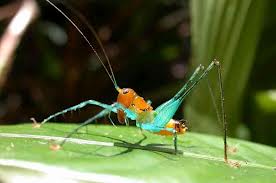
Arachnoscellis
The crickets, Arachnoscelis, from the Katydid family, which
live in the tropical rain forests, can produce the highest-frequency ultrasound of any known insect. These extraordinary sounds are emitted by the lonely male Arachnoscelis, which makes its presence known with a burst of intense sounds. In fact, insects from the Orthoptera Order (cricket, grasshopper and locusts) are famous for their ability to sing, and most emit chirps at frequencies humans can hear. Listen to their calls below!
Arachnoscelis arachnoids, a rare species of katydid from Central Northeast of Colombia, uses elastic energy and wing movement to reach volumes greater than 110 decibels, which is louder than a diesel truck or a subway train.
http://www.sci-news.com/biology/science-bushcricket-colombia-01265.html
How do they create these sounds?
Some katydid species produce ultrasonic chirps by rubbing their fore wings together, pushing a scraper on one wing across a series of pegs on the other, but Arachnoscelis can chirp at 130 kilohertz, which is too high a frequency to be generated by merely rubbing the wings together. The wings are rubbed against each other and the scraper wedges itself behind one of the pegs, provoking a distortion. When the scraper is freed, it springs back into shape, emitting an ultrasound. By using elastic energy, the animal saves metabolic energy, as the muscles do not contract at an almost impossible speed.
| Smallest Primate |
Philippine Tarsier
One of the world's smallest primates, the Philippine Tarsier, can communicate in ultrasound, according to a study published in the British Royal Society journal Biology Letters. The tarsier is the only primate known to communicate in this way.
http://www.bbc.co.uk/nature/life/Tarsier
http://www.arkive.org/philippine-tarsier/tarsius-syrichta/
==
How do bats use Ultrasonic Echolocation to find their prey?
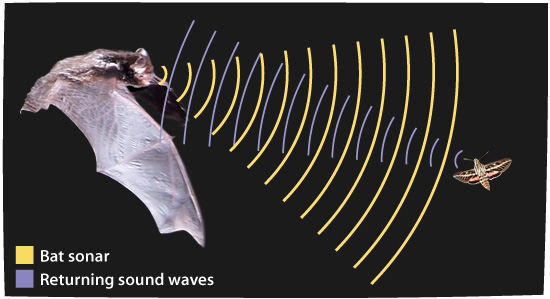
Bats, dolphins and man-made submarines emit a very high pitched beeping sound. You can listen to a Silver-haired bat screech from the Western Ecological Research Center here: http://askabiologist.asu.edu/sites/default/files/resources/articles/bats/silver_haired.mp3
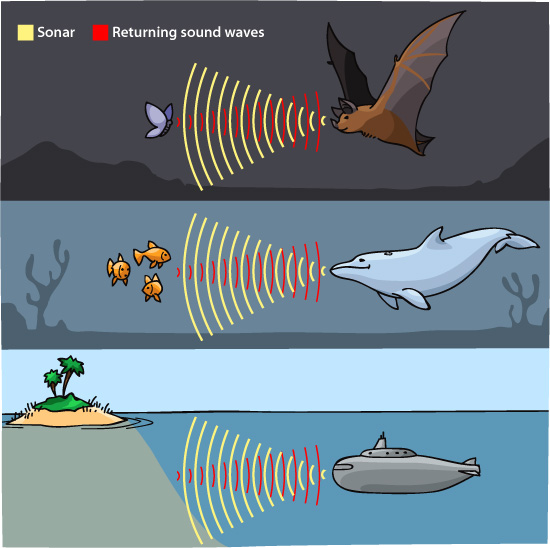
Taken from:
Elizabeth Hagen. "Bats." ASU - Ask A Biologist. 4 Nov 2009. ASU - Ask A Biologist, Web. 12 Mar 2014. http://askabiologist.asu.edu/echolocation
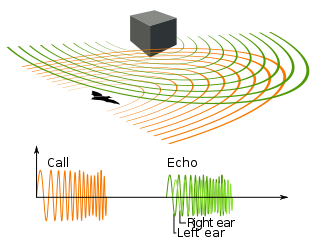
This image shows the sound waves emitted and then detected by a bat, after they bounce off an object.
More Information on Bats
Bat Echolocation
http://en.wikipedia.org/wiki/Animal_echolocation
Scientific American, How Do Bats Echolocate?
http://www.scientificamerican.com/article/how-do-bats-echolocate-an/
How do whales and dolphins use Ultrasound and Echo Location?
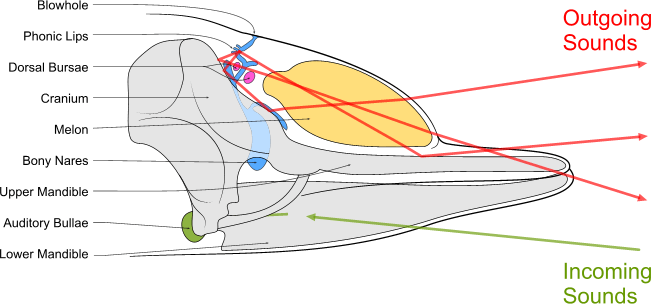
This image shows the areas in the dolphins head that produce the sounds and also detect them
The dolphin's echolocation process goes like this:
1) The dolphin uses nasal passages to make a click and sends it through its forehead, which focuses the sounds together into a beam before sending it into the water.
2) When the sound hits an object in the water, it bounces back to the dolphin as an echo.
3) The dolphin absorbs this returning echo through its jaw.
4) A passage of fat from the jaw conducts the sound to the dolphin's inner ear, which exchanges nerve impulses with its brain to interpret the object's characteristics, such as size, shape and material.

The Amazing Story of Ben Underwood aka. the "Bat Boy," a blind boy who used Echolocation to be able to "see" his surroundings
Ben Underwood was a very special kid. He was blind since the age of 3 when he had to have both eyes removed due to cancer. His mother helped him to believe that he could still do mostly anything he wanted to do even though he could not see. Ben learned to use clicking sounds and echolocation in the same way in which bats and dolphins use it. Using this method to avoid obstacles, he was able to ride bikes, play basketball and many other activities most blind people are never able to do. Sadly, Ben passed away in 2011 after his cancer returned. Watch the film above to learn more about his miraculous life!
Tribute to Ben Underwood
http://www.benunderwood.com/index.html
The Guardian
http://www.theguardian.com/lifeandstyle/2007/jan/27/familyandrelationships.family2
Educational Materials
Here is an educational Powerpt presentation which contains some of the information on this page. It is for use when teaching children about ultrasonic distance sensors. Your feedback is welcomed on the materials on this page and in the Powerpt. Please email me at: maryalice@yourduino.com.
Toot hed Whale Echolocation
http://en.wikipedia.org/wiki/File:Toothed_whale_sound_production.png
TED Talk: Using Ultrasonics and Lasers to Track Down Mosquitos
http://www.youtube.com/watch?v=YnSKrzmpKGw
Pawnation: What kinds of animals have ultrasonic hearing and how do they use it?
http://animals.pawnation.com/kinds-animals-ultrasonic-hearing-3682.html
Primates and Other animals that Communicate Through Ultrasound,
International Business Times, By Amir Khanon February 08 2012 12:28 PM
http://www.ibtimes.com/primates-and-other-animals-communicate-through-ultrasound-slideshow-554060
The Top 7 Ultrasound Emitting Animals
http://news.softpedia.com/news/Top-7-Ultrasound-Emitting-Animals-74541.shtml
Echolocation and Ultrasound
http://www.bbc.co.uk/nature/adaptations/Ultrasound


